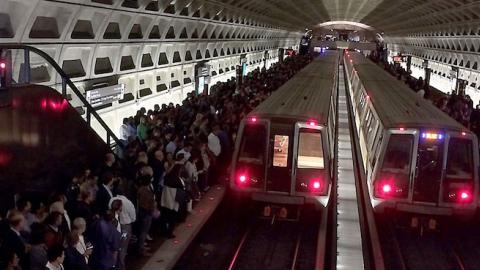Washingtonians are preparing for a hellish November. Because it is in such disrepair, Metro's Red Line will be operating significantly below capacity until Thanksgiving (that's assuming all goes as planned). Outer segments will be closed and fewer trains will run. WMATA is running shuttle buses to fill the void, but even Metro officials don't expect that to improve commutes very much. Meanwhile, the Washington Post got a hold of the proposed 2017 Metro budget and it's not a pretty picture:
[Metro General Manager Paul J. Wiedefeld] is planning to request an additional $130 million from the District, Virginia and Maryland to help close an anticipated $290 million budget shortfall for the budget year that begins July 1 — a gap that is $15 million higher than estimated in recent projections to the board.
Under Wiedefeld’s proposed fare increases, bus fares would rise 25 cents, to $2 per ride. For rail passengers, the minimum and maximum fares would increase to $2.25 and $6 respectively — up from $2.15 and $5.90. Off-peak trip fares on Metro would increase 25 cents, while peak-trip fares would increase a dime. The cost of daily parking would also increase by 10 cents.
The proposal would also slash rail and bus service, increasing average rail wait times during peak hours from 6 to 8 minutes, and eliminating about a dozen unspecified “low-ridership” bus routes. Metro says trains would arrive every 2 to 4 minutes at transfer stations in the system’s core. But outside of peak hours, trains would arrive every 15 minutes.
Worse service for more money! What's not to like?
Metro has many problems, from a lax safety culture to powerful union interests which often operate at cross-purposes to riders. The new Metro budget doesn't account for it, but the unions are presently negotiating with WMATA for "across-the-board" wage increases. Given past experience, it's safe to assume they will get at least some of what they're seeking. That could mean another set of fare hikes.
Metro's ongoing challenges raise the question of mass rail transit's longterm sense for Washington. To be sure, the infrastructure exists and many riders still rely on the trains. But looking ahead, it's not clear that making major investments in Metro is a smart idea. In addition to the cost problems, the system was designed along the "hub-and-spoke" model which aims to bring commuters into a central downtown area and where people live and work in DC is changing. Getting from the outskirts of DC to the core is easy (assuming the trains aren't shut down for track work), but getting from one side of the city to the other is hard. If you live one neighborhood east of your office, the fastest Metro commute might be to go south to downtown, switch trains, and then head back north to work. More and more, this is what DC residents' commutes look like. Furthermore, trains save more time over longer trips and DC isn't really big enough to realize substantial advantages for many commuters. In New York, commutes can be 45 minutes or even over an hour and easily cover 5 or 6 miles. In DC, most people get to work in 25 minutes and cover 2 or maybe 3 miles. Over half of a Washingtonian's commute could easily be walking.
Uber Pool and Lyft Line have been offering $3 door-to-door rush hour trips to many DC residents for months. These fares are almost certainly subsidized—the profitability of $3 rides remains to be proven. But commuters are definitely finding alternative forms of transit. Metro has seen ridership fall over the past few years even as more people come to work in Washington. As ridership falls, revenue falls, and that puts additional pressure on Metro's budget.
It's risky to make predictions about urban development, but it's increasingly realistic to predict the Metro will serve only a niche customer base in the DC transportation ecosystem ten years from now. The system's map is outdated, its infrastructure needs big investments just to stay safe, labor costs are rising and Metro has no plan to automate as some European mass transit systems have done. Once self-driving cars and buses come online and ride-sharing algorithms improve, taking the train to work probably won't make sense for most DC residents.
Self-driving vehicles are why, in the end, this isn't actually such a depressing story. There may be no light at the end of the tunnel for WMATA, but for DC residents cramped on shuttle buses this month, a better commute is around the corner.
















